site search
online catalog
SCARCE, IDENTIFIED AND SOLDIER-MODIFIED ISSUE INFANTRY OVERCOAT: EMANUEL CAVE CO. H 69th OHIO, WIA MISSIONARY RIDGE

Hover to zoom


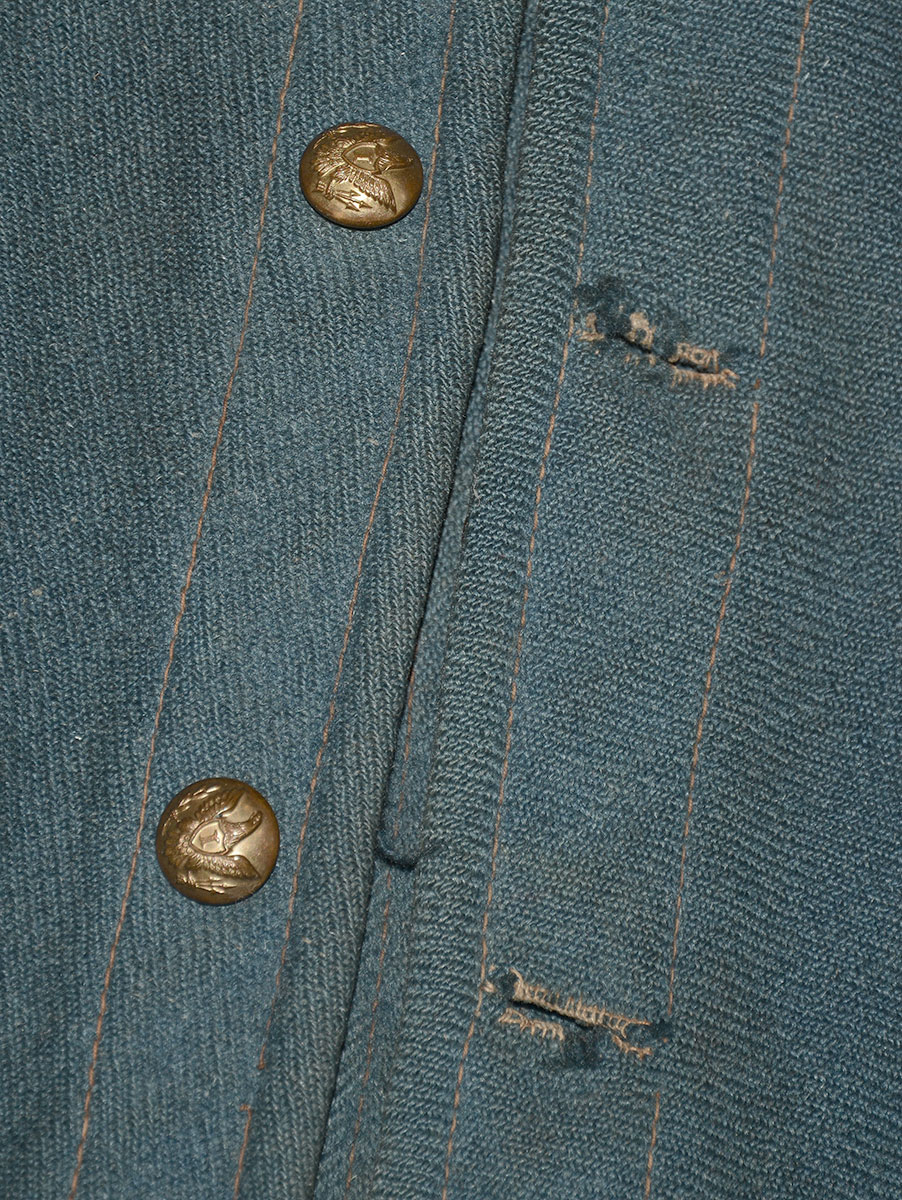

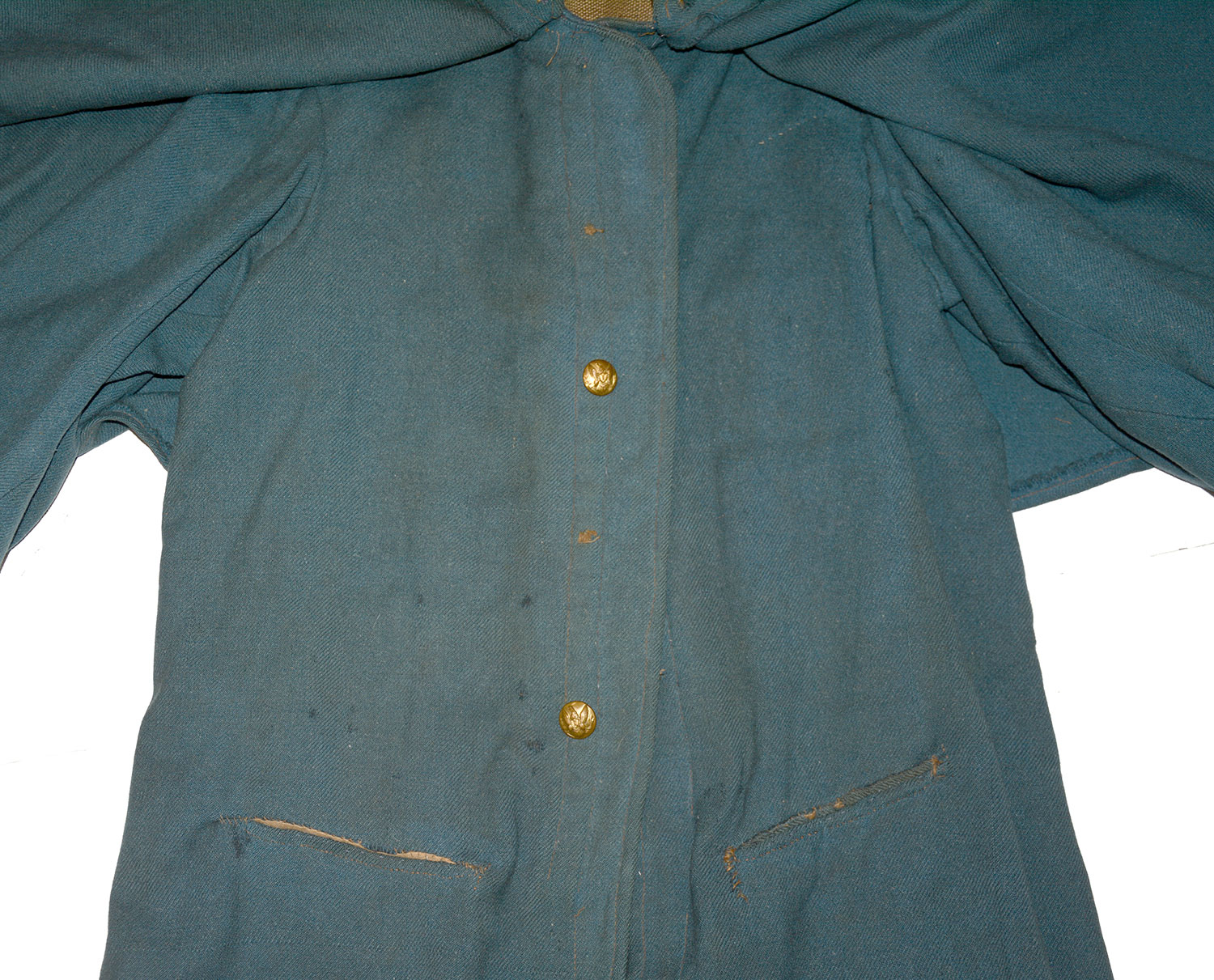

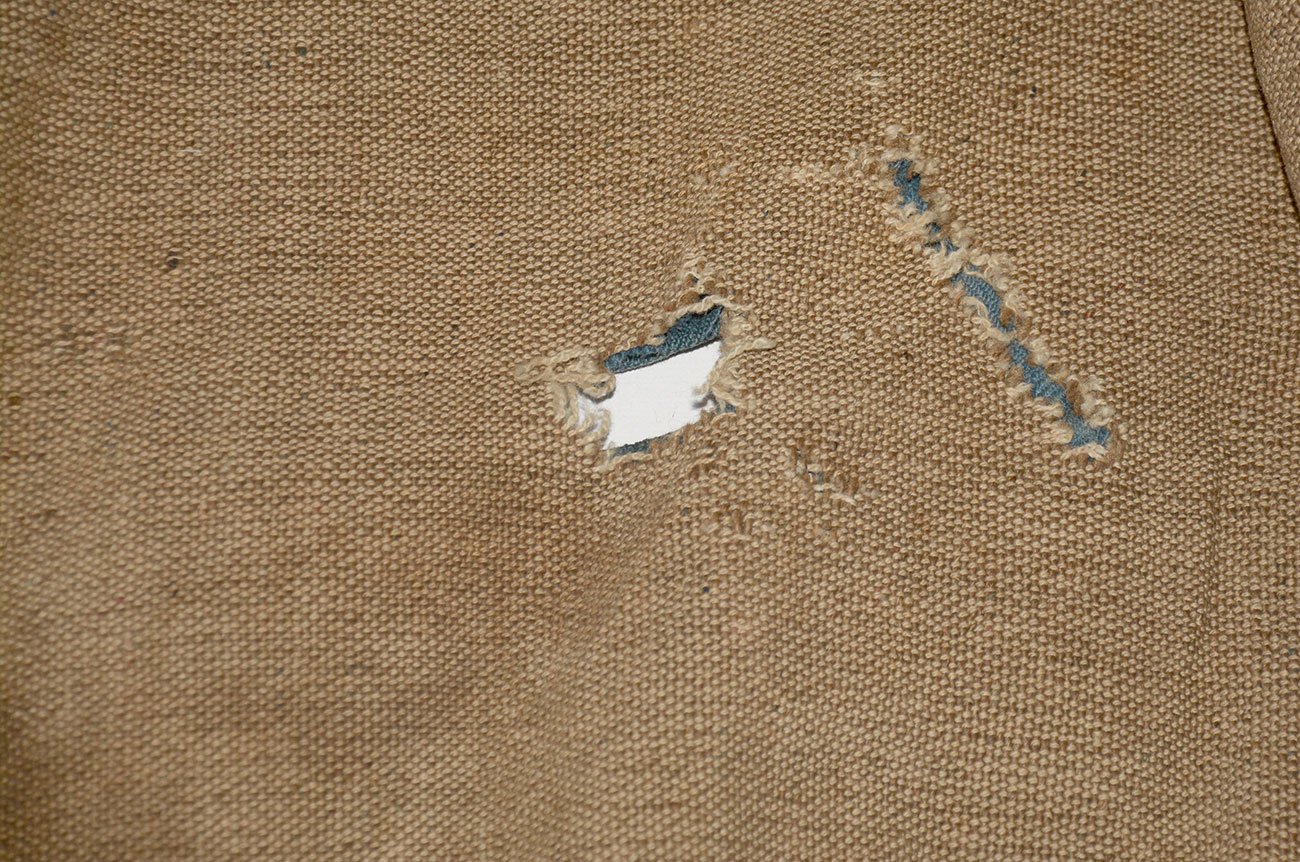

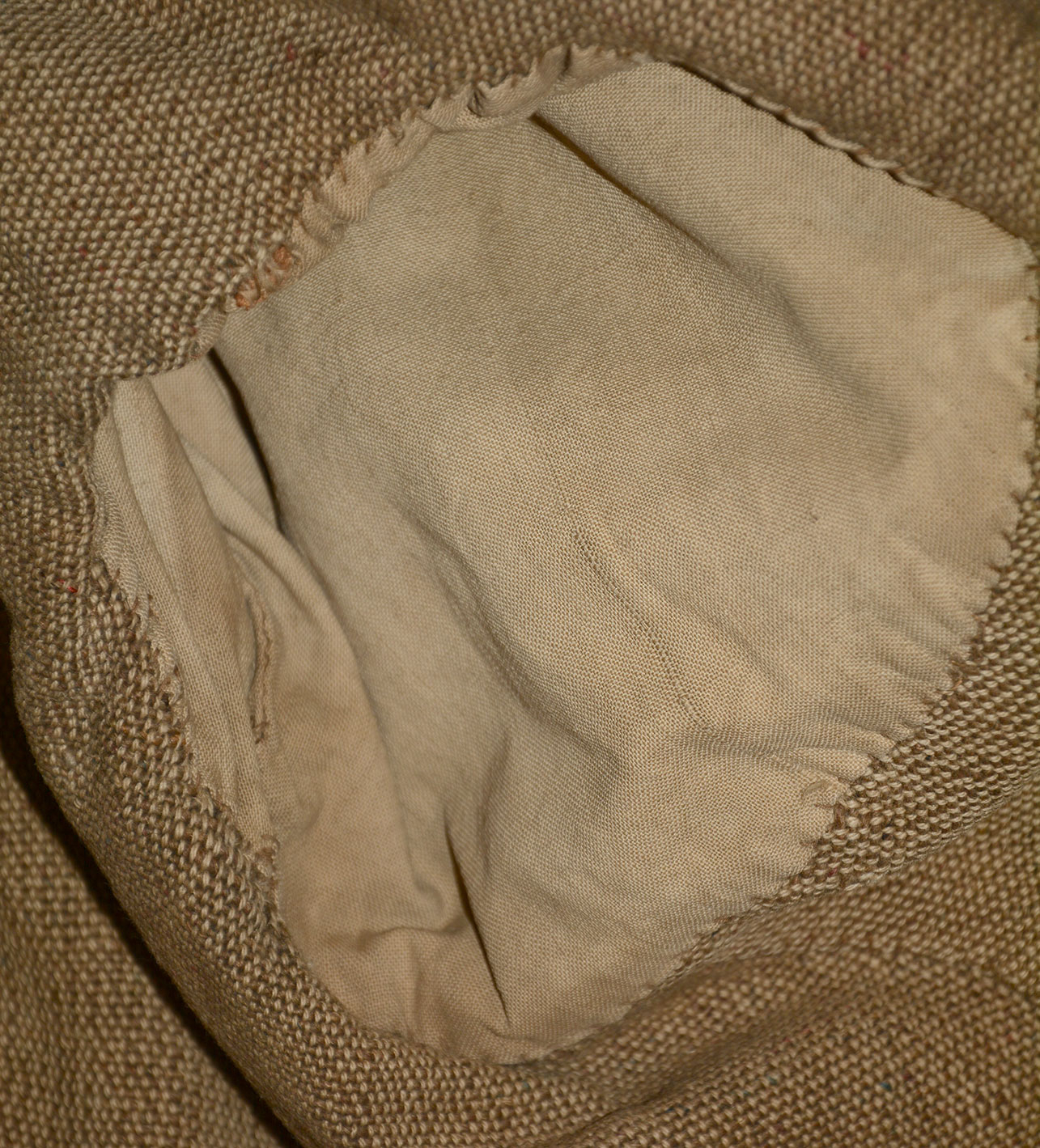
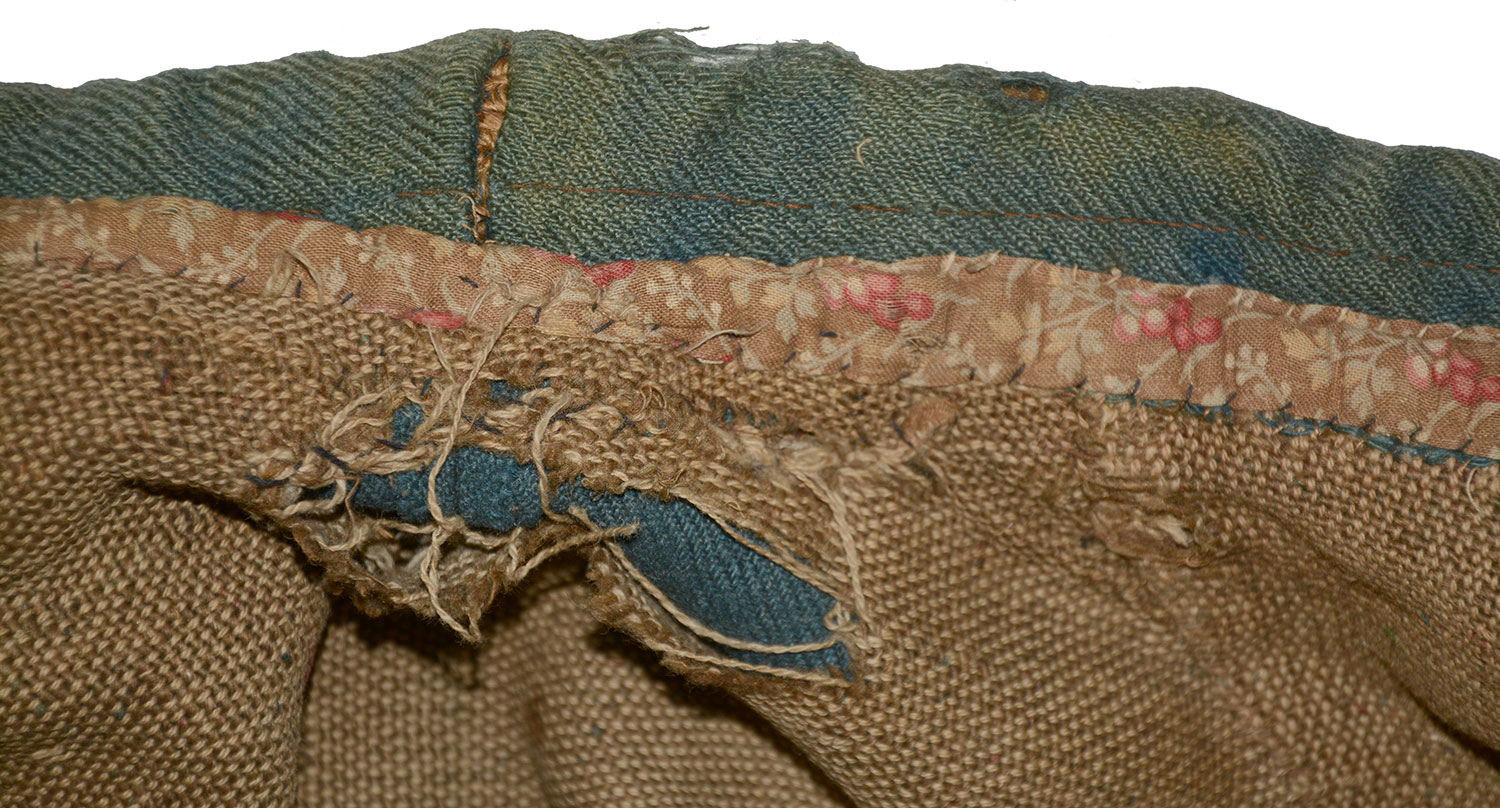
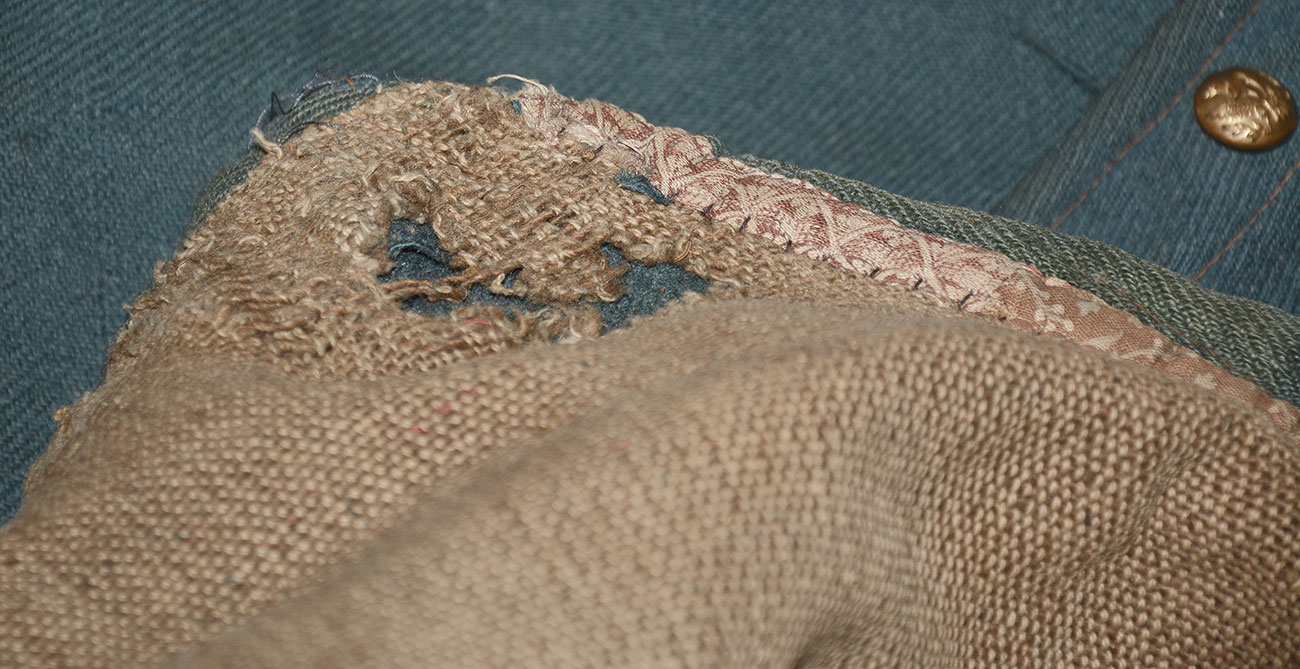


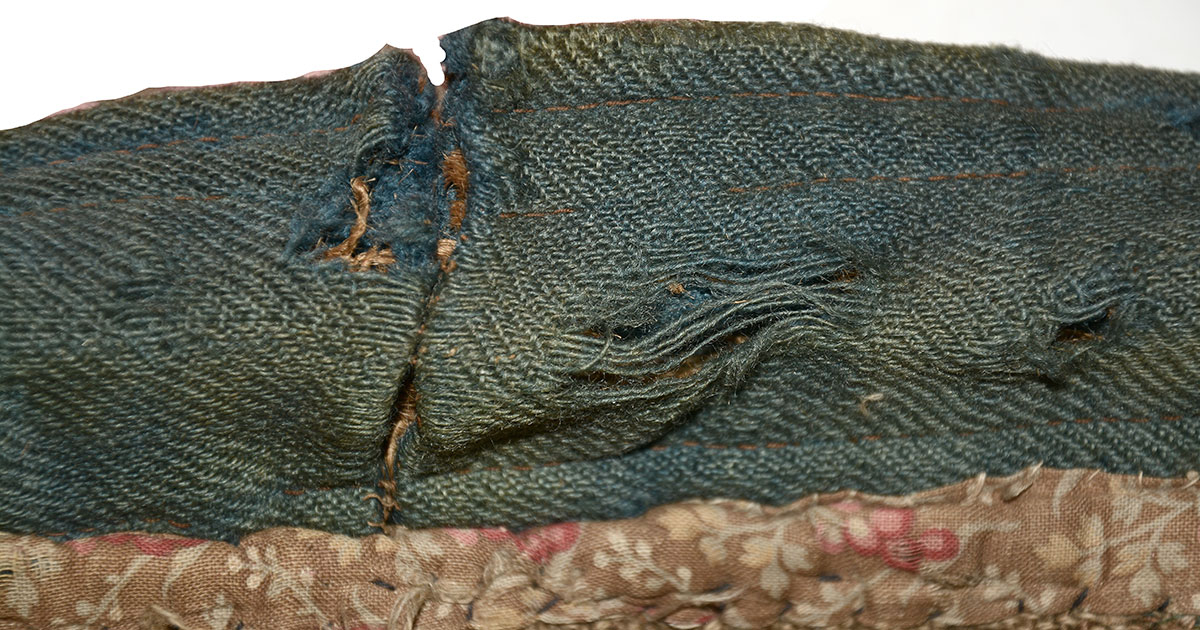

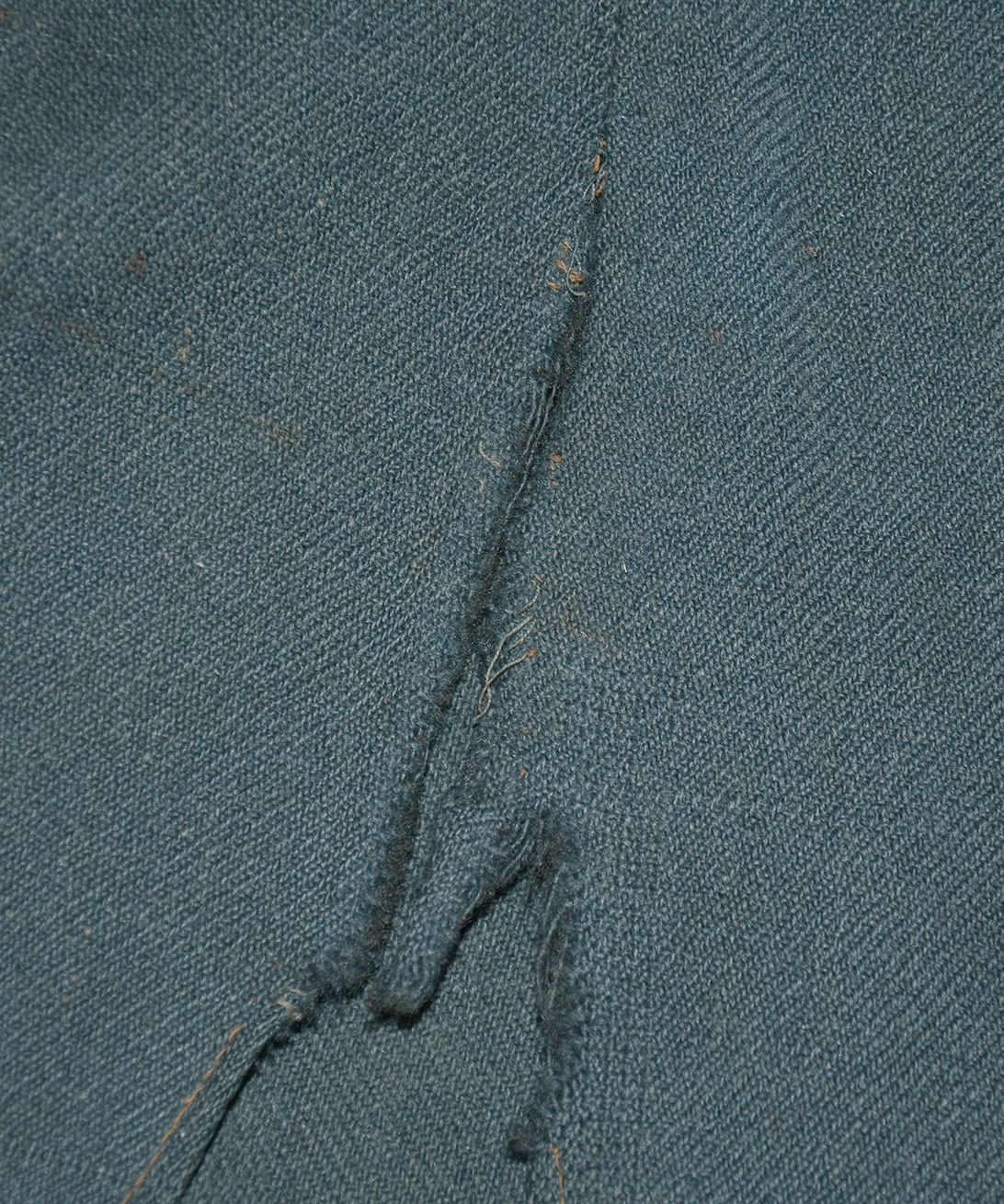

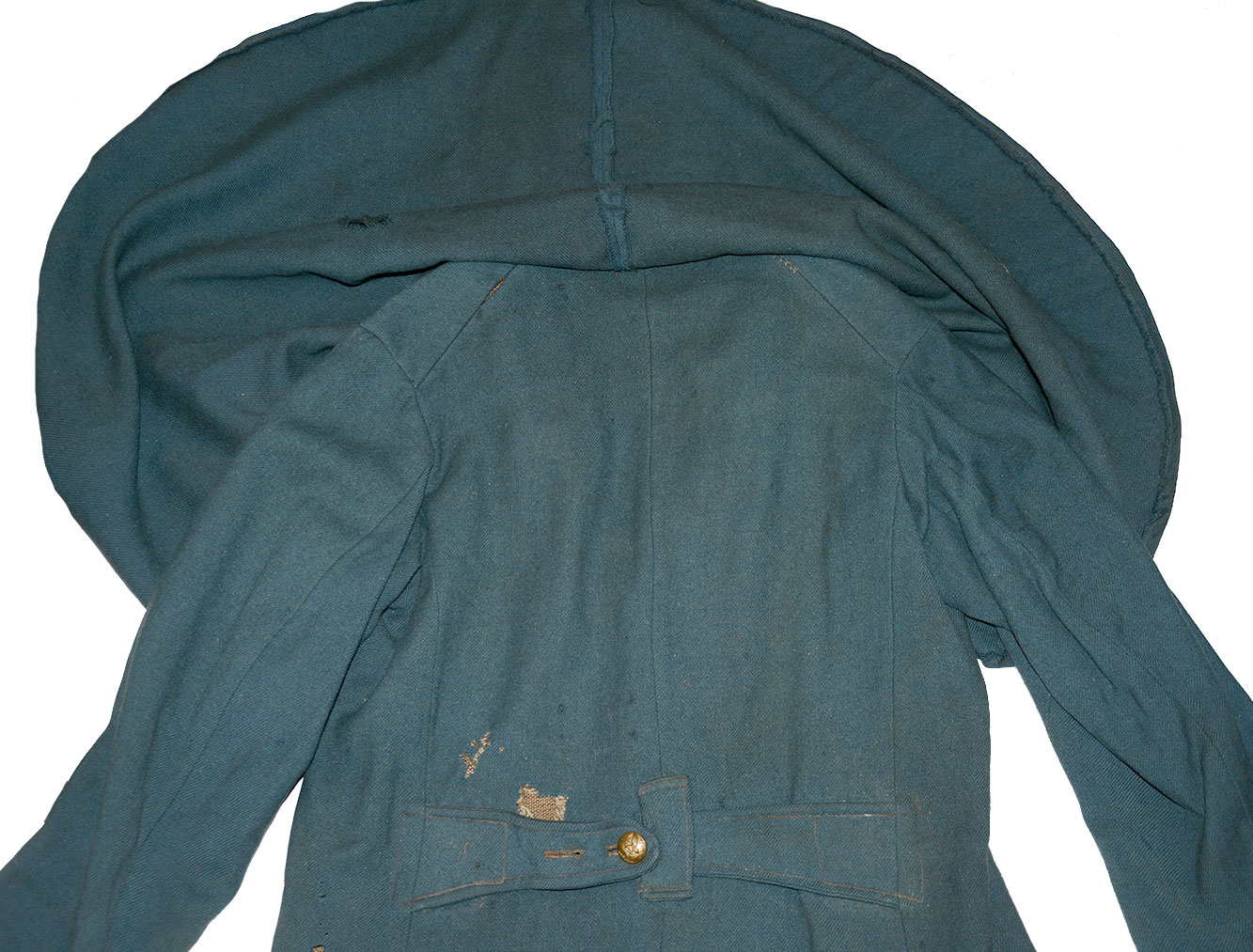
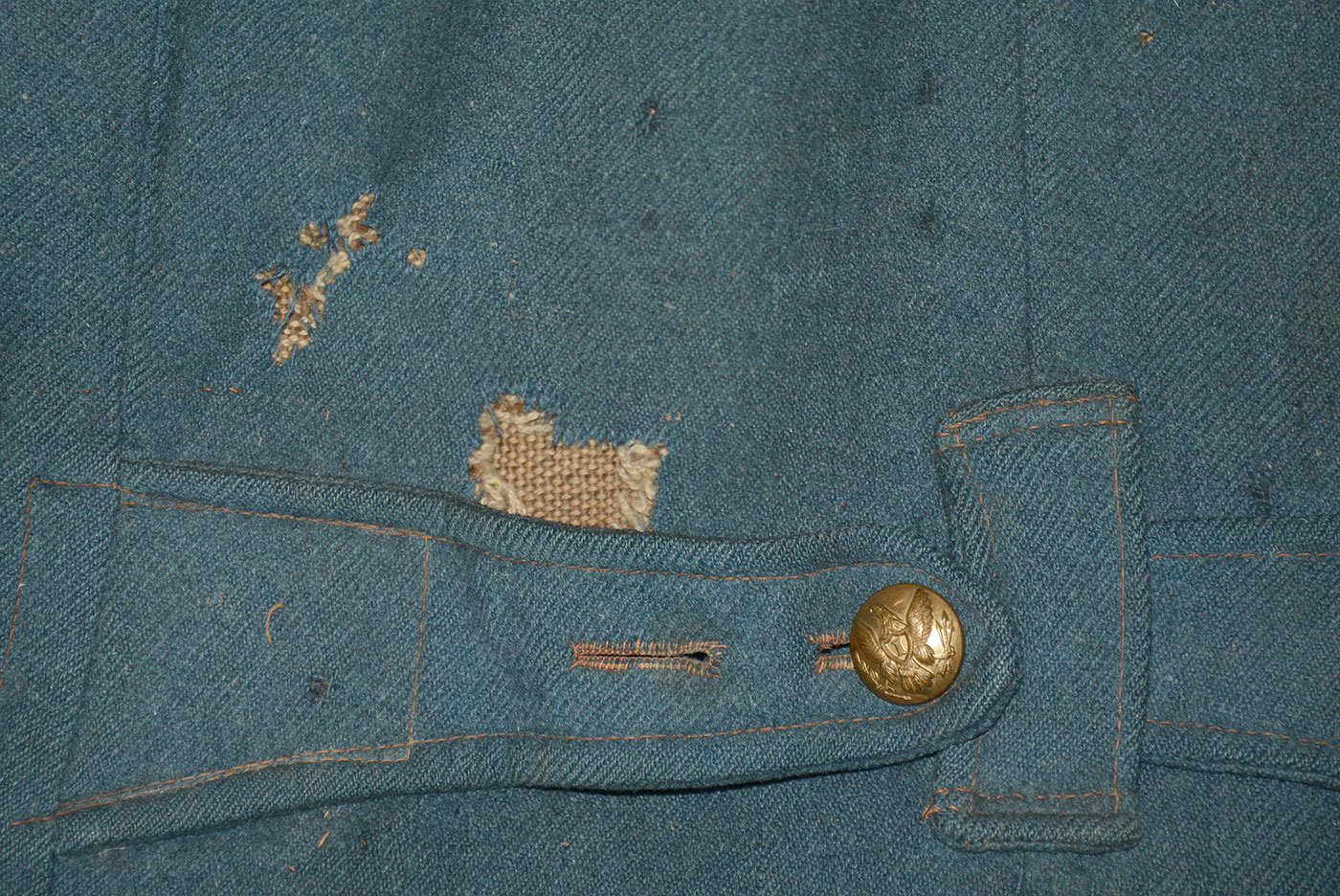

$6,500.00
Quantity Available: 1
Item Code: 1268-273
Shipping: Determined by Method & Location of buyer
To Order:
Call 717-334-0347,
Fax 717-334-5016, or E-mail
This regulation issue infantry overcoat was brought home by Emanuel Cave. Co. H, 69th Ohio, descended directly in the family to a great-grandson along with Cave’s knapsack and canteen, comes with two old handwritten and one typewritten notes on the provenance, as well as service and pension records, and was most recently in the Texas Civil War Museum. It is not only a good example of a regulation coat made and marked by a known contractor, and used by a soldier in the western campaigns, but also shows some personal touches by the soldier, who substituted officer-style Eagle Infantry-I buttons for the issue general service buttons and, for comfort and convenience in a coat that was made without pockets, added a breast pocket and two waist pockets. The coat is in very good condition, showing wear, use, and some minor moth damage, but is solid, retains good color, and displays very well.
The shoulder of the left sleeve lining still has the oval, black ink maker’s stamp reading, “J.D. BALDWIN / PITTSBURG PA.” and the single dot size marking indicating the standard army size 1. Bazelon notes that among Baldwin’s various army Civil War army contracts he had a contract on 10/20/62 for 5,000 infantry overcoats, and another for 10,000 infantry overcoats on 6/27/64. It follows the standard pattern for the overcoat, or “greatcoat,” for enlisted foot troops from 1851 through the Civil War and several years thereafter, described in detail in the 1865 Quartermaster’s Manual, featuring a standing collar fastened at the front by two sets of hooks and eyes, a cape sewn to the lower edge of the collar and fastened by six small button, a single-breasted body fastened by five large buttons, a two-piece adjusting belt with supporting loop fastened by one large button, long skirts with tall central vent, and sleeves with long cuffs, The coat lined in the upper body and the sleeves only.
The coat has a regulation standing collar made with interlining as a stiffener, about 3-inches tall, fastened at the front by two sets of iron wire hooks and eyes. One eye remains. The other elements were pulled or torn out and the openings closed up. The collar was clearly worn rolled over and that edge shows some wear along the top, with one threadbare 1” spot at left rear, and the rear seam is open for about 1-inch also, with two small moth nips just to its left. As is correct, the cape is sewn in place around the base of collar, is roughly elbow length, unlined and fasted by six small cuff-size buttons, all in place, showing old thread and as noted above officer eagle-I patterns. The only noticeable moth damage is a pencil eraser size hole at top of the left shoulder and a 1” by 1-1/2” hole on the lower left shoulder.
The body of the coat is full length. As is correct the bottom edge is unhemmed. The third and fifth buttons on the front are in place (officer infantry-I pattern;) the others are missing. The buttonholes all show use. There are a couple of small moth nips next to the left armpit, and one ½” hole, but no significant moth damage or wear spots. The sleeves are good. The edge of the left cuff was sewn down. The right was not. A pocket was added on each side, opening outside at the waist, but were closed up. The pocket bag is present inside on the wearer’s left, but is torn off and missing on the right. The left pocket opening shows short, mended tear on the corner nearest the coat edge.
The adjusting belt and support loop are present at the rear waist, with the single button, an officer infantry-I. The are three moth holes in the back: the largest is 2” at left center, partially concealed by the adjusting belt, along with a 1”x 1-1/2” hole just above and to the side of that, and a small ½” hole lower down. The rear vent is about 14” long from the lower edge and the rear seam has parted for about 4” above that and could be resewn. None of these affect the structural integrity of the coat, however, and the two largest holes are concealed by the adjusting belt and cape when displayed.
The interior is lined in the typical loosely woven brown wool fabric in the body and white muslin in the sleeves. Both are complete, though the body lining shows expected wear spots at the upper back just below the collar (a 3” and a 1” frayed section, about ½” each,) at the edges of the armpits, and at either side of the top of the lapel, and has holes corresponding to the moth holes in the wearer’s lower left back. An interior pocket was added in the upper left chest, and seems professionally done, by a company tailor or skilled comrade, and there is a half-circle patch made to the lining a little above that.
Emanuel Cave was born in Ohio in 1838, married in March 1861, but enlisted 2/6/62 at Circleville, OH, at age 23, mustering in for three years on 3/8/62 as a private in what became Company H of the 69th Ohio. He was wounded in action at Missionary Ridge in November 1863, but reenlisted as a Veteran Volunteer on 2/21/64, mustering in for another three years, at Chattanooga, which earned him a veteran furlough home. He survived to muster out with the regiment 7/17/65 at Louisville, KY, and return home, though with several lifelong health complaints attributed to army service. When he reenlisted as a veteran he was described as having blue eyes, auburn hair, a light complexion and standing 5’10” and then as age 24 and a farmer by occupation.
The regiment spent most of its service in the 14th Corps, Army of the Cumberland. Dyer summarizes their service as follows:
Moved to Camp Chase, Ohio, February 19, 1862, and duty there until April 1862. Moved to Nashville, Tenn., April 19–22, thence to Franklin, Tenn., May 1, and duty there until June 8. Moved to Nashville, Tenn., June 8, 1862, thence to Murfreesboro, Tenn. Expedition to McMinnville and Pikesville June 12–20. Provost duty at Nashville until December. Expedition to Gallatin and action with Morgan August 13. Siege of Nashville September 12-November 7. Near Nashville November 5. Nashville and Franklin Pike December 14. Advance on Murfreesboro December 26–30. Battle of Stones River December 30–31, 1862 and January 1–3, 1863. Duty at Murfreesboro until June. Tullahoma Campaign June 23-July 7. Occupation of middle Tennessee until August 16. Passage of the Cumberland Mountains and Tennessee River, and Chickamauga Campaign August 16-September 22. Battle of Chickamauga September 19–21 (supply train guard during the battle). Rossville Gap September 21. Siege of Chattanooga, Tenn., September 24-November 23. Orchard Knob November 23–24. Missionary Ridge November 25. Graysville November 26. Duty at Rossville, Ga., until March 1864. Veterans absent on furlough March 16-May 11, rejoin at Buzzard's Roost, Ga. Atlanta Campaign May to September. Demonstration on Rocky Faced Ridge May 8–11. Battle of Resaca May 14–15. Advance on Dallas May 18–25. Operations on line of Pumpkin Vine Creek and battles about Dallas, New Hope Church and Allatoona Hills May 25-June 5. Pickett's Mills May 27. Operations about Marietta and against Kennesaw Mountain June 10-July 2. Pine Hill June 11–14. Lost Mountain June 15–17. Assault on Kennesaw June 27. Ruff's Station. Smyrna Camp Ground, July 4. Chattahoochie River July 5–17. Peachtree Creek June 19–20. Siege of Atlanta July 22-August 25. Utoy Creek August 5–7. Flank movement on Jonesboro August 25–30. Battle of Jonesboro August 31-September 1. Lovejoy's Station September 2–6. Operations against Hood in northern Georgia and northern Alabama September 29-November 3. March to the sea November 15-December 10. Siege of Savannah December 10–21. Campaign of the Carolinas January to April, 1865. Near Cheraw, S.C., February 28. Taylor's Hole Creek, Averysboro, N. C., March 16. Battle of Bentonville March 19–21. Occupation of Goldsboro March 24. Advance on Raleigh April 10–14. Occupation of Raleigh April 14. Bennett's House April 26. Surrender of Johnston and his army. March to Washington, D.C., via Richmond, Va., April 29-May; Grand Review of the Armies May 24. Moved to Louisville, Ky., June, and duty there until July.
They lost 89 officers and enlisted men killed or mortally wounded, and several times that in wounded who recovered. This included Resaca (5 killed and 26 wounded,) Pumpkin Vine Creek and Dallas (5 killed and 19 wounded,) Kennesaw Mountain (2 killed,) Marietta, (1 killed and 7 wounded,) Peachtree Creek (1 killed and 10 wounded,) Atlanta (9 men wounded, 2 mortally,) Jonesboro (8 killed and 36 wounded, some mortally,) the March to the Sea and Campaign of the Carolinas (2 killed and 8 wounded.)
Cave is listed as detailed as a train guard at Stevenson, AL, in late October 1863, but this may be a reference to the supply train guard duty of the whole regiment at the time. In any case, he with the regiment at Missionary Ridge in late November, where he suffered a flesh wound to the left arm, between elbow and shoulder. He seems to have been hospitalized at Chattanooga, Bridgeport and Nashville for about two months, but was with the company to reenlist as a veteran in February 1864. In early May 1864 at Snake Gap Creek, GA, he suffered a rupture, which did not hospitalize him, but left him with a hernia. His Captain recalled in 1896 the injury had kept him away from the company until mid-August, but other testimony puts him back with the company sooner, for he was in the fighting at Peachtree Creek in late June, where nearby artillery fire from guns they were supporting cost him his hearing in his right ear (and may have been responsible for dizziness and temporary vision loss that he experienced during the March to the Sea.) After mustering out, Cave returned to his wife in Circleville, where he remained for the rest of his life, listing himself as a farm laborer in 1870 and a well-digger in 1880, the couple eventually raising 7 children. He passed away in 1916. The coat, with his canteen and knapsack, was passed to his son William, his daughter, and then her son. The whereabouts of the canteen and knapsack are unknown. The coat has visual appeal, combining good condition with clear signs of issue, field use, and personalization by the soldier in the upgrade of the buttons and the addition of pockets. It was a good addition to the collection of the Texas Civil War Museum and would be a good addition to yours. [sr][ph:L]
~~~~~~~~~~~~~~~~~~~~~~~~~~~~~~~~~~~
THIS ITEM, AS WITH ALL OTHER ITEMS AVAILABLE ON OUR WEB SITE,
MAY BE PURCHASED THROUGH OUR LAYAWAY PROGRAM.
FOR OUR POLICIES AND TERMS,
CLICK ON ‘CONTACT US’ AT THE TOP OF ANY PAGE ON THE SITE,
THEN ON ‘LAYAWAY POLICY’.
THANK YOU!
Inquire About SCARCE, IDENTIFIED AND SOLDIER-MODIFIED ISSUE INFANTRY OVERCOAT: EMANUEL CAVE CO. H 69th OHIO, WIA MISSIONARY RIDGE
Most Popular
Historical Firearms Stolen From The National Civil War Museum In Harrisburg, Pa »
Theft From Gravesite Of Gen. John Reynolds »
Selection Of Unframed Prints By Don Troiani »
Fine Condition Brass Infantry Bugle Insignia »
Large English Bowie Knife With Sheath 1870’S – 1880’S »
Imported (Clauberg) Us Model 1860 Light Cavalry Officer's Saber »
featured item
REGULATION CIVIL WAR US ARMY ISSUE BLANKET IN AMAZING CONDITION
These wool blankets were an essential piece of a Union soldier's gear. This one is full length and unaltered. It measures 66 inches wide by 80 inches in length. The ends are finished on the sides, and they are basted over 1/2 inch on the long ends to… (2025-1850). Learn More »


